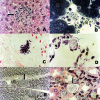Effect of three drugs against Encephalitozoon cuniculi infection in immunosuppressed mice
- PMID: 23612191
- PMCID: PMC3697356
- DOI: 10.1128/AAC.00157-13
Effect of three drugs against Encephalitozoon cuniculi infection in immunosuppressed mice
Abstract
Microsporidia comprise a large group of obligate intracellular parasites. The microsporidian Encephalitozoon cuniculi causes disseminated infection in immunosuppressed patients with HIV, cancer, or transplants and in the elderly. In vivo and in vitro studies on the effectiveness of drugs are controversial. Currently, there is no effective treatment. We tested albendazole, albendazole sulfoxide, metronidazole, and cyclosporine in mice immunosuppressed with cyclophosphamide and inoculated by the intraperitoneal route with 10(7) E. cuniculi spores. One week after experimental inoculation, the mice were treated with albendazole, albendazole sulfoxide, metronidazole, and cyclosporine. Histological and morphometric analyses were performed to compare the treated groups. The state of immunosuppression was evaluated by phenotyping CD4(+) and CD8(+) T cells by flow cytometry. Nontreated mice showed acute disseminated and fatal encephalitozoonosis. The treatment with benzimidazoles significantly reduced infection until 30 days posttreatment (p.t.), but at 60 days p.t., the infection had recurred. Metronidazole decreased infection by a short time, and cyclosporine was not effective. All animals were immunosuppressed by all the experiments, as demonstrated by the low number of CD4(+) and CD8(+) T cells. We conclude that no drug was effective against E. cuniculi, but the benzimidazoles controlled the infection transiently.
Figures

Similar articles
-
Encephalitozoon cuniculi Genotype III Evinces a Resistance to Albendazole Treatment in both Immunodeficient and Immunocompetent Mice.Antimicrob Agents Chemother. 2020 Apr 21;64(5):e00058-20. doi: 10.1128/AAC.00058-20. Print 2020 Apr 21. Antimicrob Agents Chemother. 2020. PMID: 32152088 Free PMC article.
-
Encephalitozoonosis in pharmacologically immunosuppressed mice.Exp Parasitol. 2012 Jul;131(3):339-43. doi: 10.1016/j.exppara.2012.04.019. Epub 2012 May 22. Exp Parasitol. 2012. PMID: 22626517
-
Latent microsporidiosis caused by Encephalitozoon cuniculi in immunocompetent hosts: a murine model demonstrating the ineffectiveness of the immune system and treatment with albendazole.PLoS One. 2013 Apr 11;8(4):e60941. doi: 10.1371/journal.pone.0060941. Print 2013. PLoS One. 2013. PMID: 23593356 Free PMC article.
-
Disseminated infection due to Encephalitozoon cuniculi in a patient with AIDS: case report and review.HIV Med. 2000 Jul;1(3):155-61. doi: 10.1046/j.1468-1293.2000.00022.x. HIV Med. 2000. PMID: 11737344 Review.
-
Immune response to Encephalitozoon cuniculi infection.Microbes Infect. 2001 Apr;3(5):401-5. doi: 10.1016/s1286-4579(01)01397-1. Microbes Infect. 2001. PMID: 11369277 Free PMC article. Review.
Cited by
-
Zoonotic Risk of Encephalitozoon cuniculi in Animal-Assisted Interventions: Laboratory Strategies for the Diagnosis of Infections in Humans and Animals.Int J Environ Res Public Health. 2021 Sep 3;18(17):9333. doi: 10.3390/ijerph18179333. Int J Environ Res Public Health. 2021. PMID: 34501921 Free PMC article. Review.
-
Encephalitozoon cuniculi Genotype III Evinces a Resistance to Albendazole Treatment in both Immunodeficient and Immunocompetent Mice.Antimicrob Agents Chemother. 2020 Apr 21;64(5):e00058-20. doi: 10.1128/AAC.00058-20. Print 2020 Apr 21. Antimicrob Agents Chemother. 2020. PMID: 32152088 Free PMC article.
-
Exploring bioactive molecules released during inter- and intraspecific competition: A paradigm for novel antiparasitic drug discovery and design for human use.Curr Res Parasitol Vector Borne Dis. 2025 Mar 25;7:100256. doi: 10.1016/j.crpvbd.2025.100256. eCollection 2025. Curr Res Parasitol Vector Borne Dis. 2025. PMID: 40292016 Free PMC article. Review.
-
In vitro antimicrosporidial activity of gold nanoparticles against Heterosporis saurida.BMC Vet Res. 2016 Mar 3;12:44. doi: 10.1186/s12917-016-0668-x. BMC Vet Res. 2016. PMID: 26939524 Free PMC article.
-
Enterocytozoon Bieneusi Infects Children With Inflammatory Bowel Disease Undergoing Immunosuppressive Treatment.Front Med (Lausanne). 2021 Sep 30;8:741751. doi: 10.3389/fmed.2021.741751. eCollection 2021. Front Med (Lausanne). 2021. PMID: 34660646 Free PMC article.
References
-
- Anane S, Attouchi H. 2010. Microsporidiosis: epidemiology, clinical data and therapy. Gastroenterol. Clin. Biol. 34:450–464 - PubMed
-
- Ambroise-Thomas P. 2000. Emerging parasite zoonoses: the role of host-parasite relationship. Int. J. Parasitol. 30:1361–1367 - PubMed
-
- Ferreira FMB, Bezerra L, Santos MB, Bernardes RM, Avelino I, Silva ML. 2001. Intestinal microsporidiosis: a current infection in HIV-seropositive patients in Portugal. Microbes Infect. 3:1015–1019 - PubMed
-
- Lores B, Lopez-Miragaya I, Arias C, Fenoy S, Torres J, Del Aguila C. 2002. Intestinal microsporidiosis due to Enterocytozoon bieneusi in elderly human immunodeficiency virus-negative patients from Vigo, Spain. Clin. Infect. Dis. 34:918–921 - PubMed
MeSH terms
Substances
LinkOut - more resources
Full Text Sources
Other Literature Sources
Research Materials

